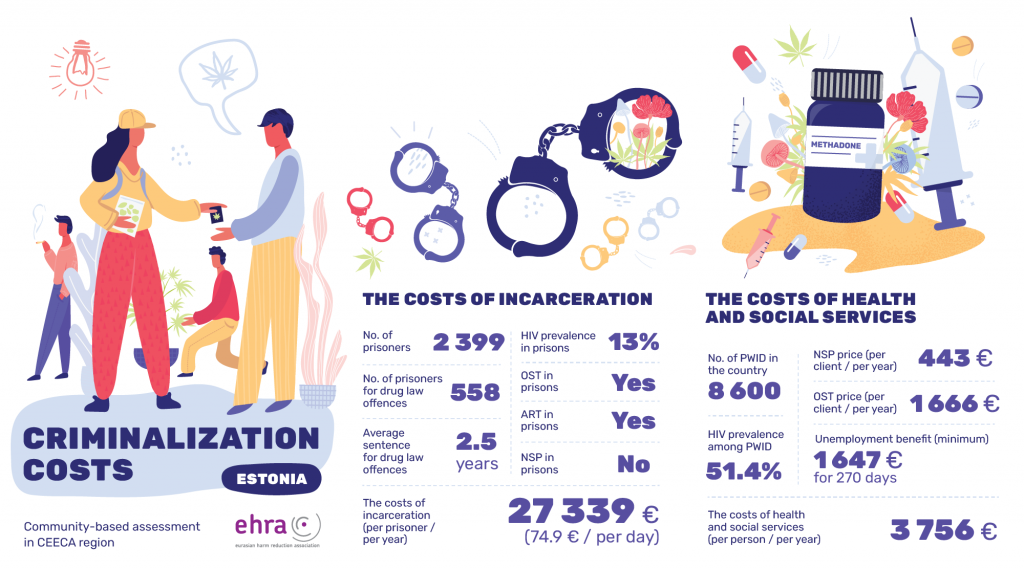There were 2,399 prisoners in Estonia in 2019 of which 558 were incarcerated for drug law offenses [1]. Drug use and possession of a small amount of an illicit drug for personal use are not criminal acts in Estonia, but misdemeanours are, for which the punishment is a fine or detention of up to 30 days [2]. The average sentence for drug law offenses is up to 2,5 years [2].
HIV prevalence among prisoners was estimated in 2017 at 13% [3] with antiretroviral therapy (ART) being available in prison [4]. Opioid substitution therapy (OST) is reported to also be available in prisons, but needle/syringe programmes (NSP) are not, in general, although some prisons cooperate with external HIV treatment hospitals and this may help to facilitate such access [5].
The cost to the government of keeping a person in prison in 2019 was €27,339 per year, or €74.90 per day [6].
In 2019, there were estimated to be 8,600 people who inject drugs in Estonia [7] with an HIV prevalence of 51.4% [8]. The cost of NSP in 2020 was about €443 per client, per year, and for OST, the cost was approximately €1,666 per client, per year [9]. Unemployment benefits totals €1,647 per person, for 270 days, or €6.10 per day [10].
Therefore, it costs the Government of Estonia €3,756 per year to provide support to a person who injects drugs in community settings, which is €23,583 per year cheaper than imprisoning that person. Consequently, through comprehensively decriminalising drug use and possession, the country could save up to €12.8 million per year.
[1] Aebi MF, Tiago MM. SPACE I – 2019 – Council of Europe Annual Penal Statistics: Prison populations. Strasbourg; Council of Europe, 2020. https://wp.unil.ch/space/files/2021/02/200405_FinalReport_SPACE_I_2019.pdf (accessed 4 August 2021).
[2] Ministry of Justice. Narcotic Drugs and Psychotropic Substances and their Precursors Act. Tallinn; Ministry of Justice, June 1997. https://www.riigiteataja.ee/akt/103052016006 (accessed 6 August 2021).
[3] Joint United Nations Programme on HIV and AIDS (UNAIDS). The Key Populations Atlas. Geneva; UNAIDS. https://kpatlas.unaids.org/dashboard (accessed 3 August 2021).
[4] Harm Reduction International (HRI). Global State of Harm Reduction 2020, Regional Overview 2.2 Eurasia. London; HRI, 2021. https://www.hri.global/files/2020/10/26/Global_State_HRI_2020_2_2_Eurasia_FA_WEB.pdf (accessed 3 August 2021).
[5] Ibid.
[6] Aebi M F, Tiago MM. SPACE I – 2020 – Council of Europe Annual Penal Statistics: Prison populations. Strasbourg; Council of Europe, 2021. https://wp.unil.ch/space/files/2021/04/210330_FinalReport_SPACE_I_2020.pdf (accessed 3 August 2021).
[7] European Monitoring Centre for Drugs and Drug Addiction (EMCDDA). Estonia Country Drug Report 2019. Luxembourg; Publications Office of the European Union, 2019. https://www.emcdda.europa.eu/system/files/publications/11337/estonia-cdr-2019_0.pdf (accessed 6 August 2021).
[8] Rüütel K, Epštein J, Kaur E. HIV infection and concomitant infections epidemiological situation in Estonia, 2010-2018. Tallinn; Institute for Health Development, 2019. In Estonian. (accessed 6 August 2021).
[9] Information submitted by the National Institute for Health Development, Tallinn.
[10] Directorate-General for Employment, Social Affairs and Inclusion. Estonia – Unemployment insurance benefit. Brussels; European Commission, undated. https://ec.europa.eu/social/main.jsp?catId=1108&langId=en&intPageId=4510 (accessed 6 August 2021).

